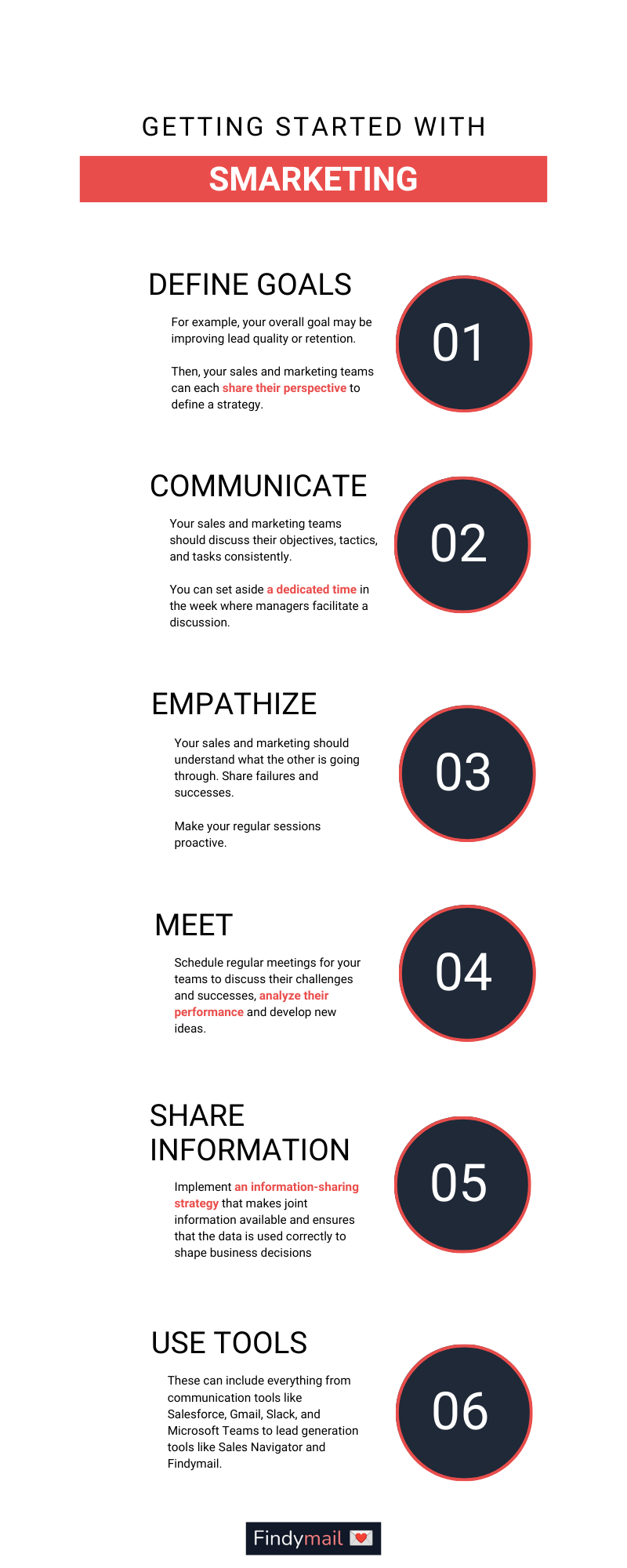Your sales and marketing teams both play crucial roles in the continued success of your business. Without effective marketing, your sales team won’t have any leads to convert.
The problem is that these teams often work in silos with distinct barriers between them, which, in turn, hampers your business’s overall performance. But what happens when you eliminate these barriers and enable your sales and marketing teams to work together?
This is what smarketing is all about! But what exactly is smarketing? Why is it important? And how do you do smarketing smart?
It’s time to find out!

What Is Smarketing?
A simple way to describe smarketing is that it’s a strategy that ensures cooperation and communication between sales and marketing departments to generate more leads and revenue.
Smarketing is when businesses bring marketing-qualified leads (MQL) and sales-qualified leads (SQL) together in a single process that allows them to:
- Grade leads
- Follow up
- Measure & track their progress and performance
This process involves marketing teams getting involved with sales teams when they follow up with leads. In turn, the process also requires sales teams to provide consistent feedback to marketing teams about the quality of the leads they’re getting and how they affect their closed-won ratio.
In other words, the aim of smarketing is to remove the boundaries between the two teams and eliminate silos to create a more dynamic relationship.
Why Is Smarketing Important?
Every business always wants to increase sales and revenue. However, they need to generate more leads and improve their retention, which is where smarketing becomes priceless.
Since smarketing aligns marketing and sales teams around the same goals, they can easily understand where in the sales funnel leads stop converting. These marketing teams can then improve their strategies to improve lead quality and increase the conversion rate.
Smarketing ensures that:
- Marketing and sales teams are always on the same page. In other words, they’ll work towards a common goal, and everyone will know what they need to do to reach their mark. For example, the marketing team might provide properly-scored leads to the sales team, which then needs to convert a certain number of these leads and give feedback on their quality.
- Businesses improve their customer experience. Sales and marketing teams interact and engage with customers in their own ways. They have a different understanding of what customers want and expect. Now, once the barriers between the teams are removed, and they communicate more, they’ll form a better, more complete understanding of their customers and deliver a more engaging customer experience from asking for meeting availability to increasing LTV through remarketing.
- Businesses generate more revenue. When businesses align their sales and marketing teams to work towards a common goal, they’ll generate more revenue. In fact, a report by the Aberdeen Group showed that businesses that align sales and marketing efforts could generate about 20% more revenue than businesses that don’t.
Source: HubSpot
How to Get Started With Smarketing
So, how do you achieve the goal of aligning your sales and marketing teams?
Fortunately, there are 6 steps you can follow on your roadmap to smarketing success:
Smarketing Step 1: Define Common Goals
As mentioned earlier, smarketing is based on your sales and marketing teams working towards a common goal. As such, as the first step, you should define common goals that your teams can work towards. When doing this, your sales and marketing managers should cooperate and use their teams’ different strengths to reach these goals.
For example, your overall goal may be improving lead quality or retention. Then, your sales and marketing teams can each share their perspective to define a strategy.
This will then lead to more effective marketing campaigns by your marketing team and more converted leads by your sales teams.
Step 2: Ensure Effective Communication
While setting common goals is crucial, your teams will reach these goals only if they communicate effectively. This means you’ll need to ensure that your teams not only understand each other's roles and strengths but also listen to feedback from one another. For this reason, your sales and marketing teams should discuss their objectives, tactics, and tasks consistently.
You can set aside a dedicated time in the week where managers facilitate a discussion on your smarketing processes and performance.
Step 3: Show Empathy
Apart from working towards a common goal and communicating effectively, your sales and marketing should understand what each other is going through. This involves sharing their failures and successes and supporting each other when times get tough, which will inevitably happen.
Make your regular sessions proactive, and invite the other team to offer advice from their point of view. While their perspectives differ, they can learn much from each other.
Ultimately, by showing empathy and understanding each other’s struggles, your teams will work better together to reach their goals and generate more revenue.
Step 4: Schedule Regular Smarketing Meetings
We’ve already mentioned that your teams should communicate effectively. To ensure that this happens, you should schedule regular meetings between your teams.
During these meetings, your teams can discuss their challenges and successes, and they can also analyze their performance and develop new ideas that could improve their performance and help them reach their goals.
Source: A Collaborative Model for Sales and Marketing
Step 5: Facilitate Information Sharing
Apart from effective communication, you should also ensure that both your sales and marketing teams have all the information they need to reach their goals.
They should have all the data necessary to analyze their performance and gain insights into how they can improve. To do this, you’ll need to implement an information-sharing strategy that makes this information available and ensures that the data is used correctly to shape business decisions.
Step 6: Use the Right Tools for Smarketing
Finally, you should use the right tools to ensure effective communication and collaboration between your teams. These can include everything from communication tools like Salesforce, Gmail, Slack, and Microsoft Teams to file-sharing tools like Dropbox and Google Drive. For instance, sharing event details or exclusive gated content with leads is more efficient with a quick QR code generator, which allows you to create scannable codes in seconds for landing pages or contact forms and improve cross-channel campaign results.
Your smarketing action force can even strategize the approach to key leads together once they get the necessary email addresses on LinkedIn with Findymail. And that’s just the tip of the iceberg!
Isn’t it Time You Implemented Smarketing in Your Business?
Your marketing and sales teams are two critical pillars of your business, but one without the other won’t amount to much. Unlock the real power in your teams by aligning their efforts and making them work towards a common goal.
Soon enough, you’ll be implementing account-based marketing programs no one in your industry can dream of!






